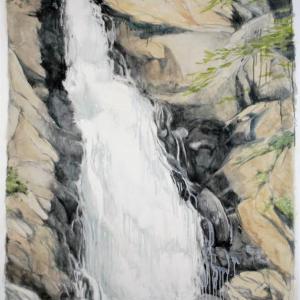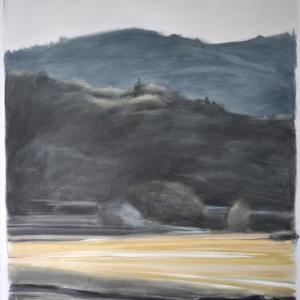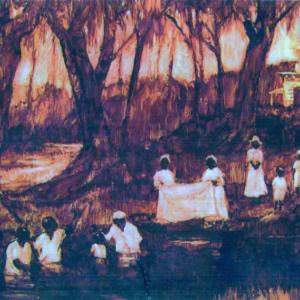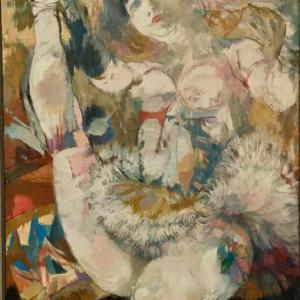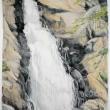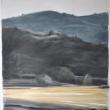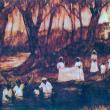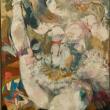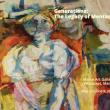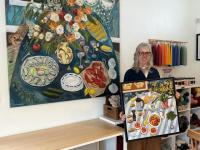Artful connection: Marguerite Robichaux and Tom Cavanaugh
 Marguerite Robichaux’s “Little Poplar Falls” bears her signature “drip technique.” Courtesy of the artist
Marguerite Robichaux’s “Little Poplar Falls” bears her signature “drip technique.” Courtesy of the artist
 “Vermont Landscape” by Marguerite Robichaux.
“Vermont Landscape” by Marguerite Robichaux.
 Thomas Cavanaugh’s “Baptism,” one of 36 paintings in his show in 2013 at his Bay Street Studio. File image
Thomas Cavanaugh’s “Baptism,” one of 36 paintings in his show in 2013 at his Bay Street Studio. File image
 “CanCan” – an example of an early work by Thomas R. Cavanaugh from the collection of Marguerite Robichaux.
“CanCan” – an example of an early work by Thomas R. Cavanaugh from the collection of Marguerite Robichaux.
 Tom Cavanaugh’s “Fish Cutter” is the cover of this show’s keepsake catalog. Gallery FB page
Tom Cavanaugh’s “Fish Cutter” is the cover of this show’s keepsake catalog. Gallery FB page
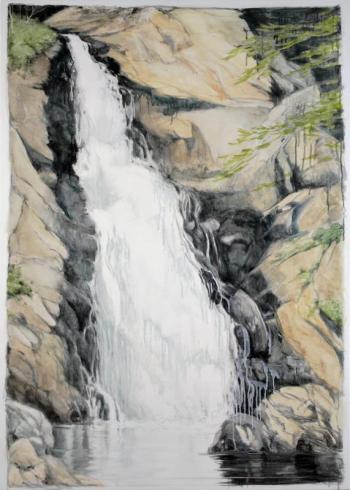 Marguerite Robichaux’s “Little Poplar Falls” bears her signature “drip technique.” Courtesy of the artist
Marguerite Robichaux’s “Little Poplar Falls” bears her signature “drip technique.” Courtesy of the artist
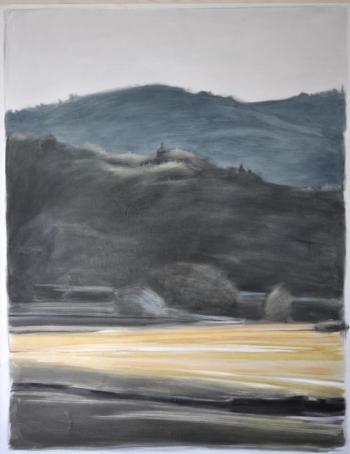 “Vermont Landscape” by Marguerite Robichaux.
“Vermont Landscape” by Marguerite Robichaux.
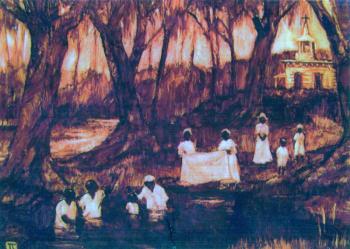 Thomas Cavanaugh’s “Baptism,” one of 36 paintings in his show in 2013 at his Bay Street Studio. File image
Thomas Cavanaugh’s “Baptism,” one of 36 paintings in his show in 2013 at his Bay Street Studio. File image
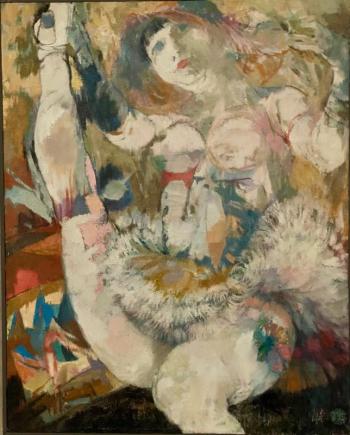 “CanCan” – an example of an early work by Thomas R. Cavanaugh from the collection of Marguerite Robichaux.
“CanCan” – an example of an early work by Thomas R. Cavanaugh from the collection of Marguerite Robichaux.
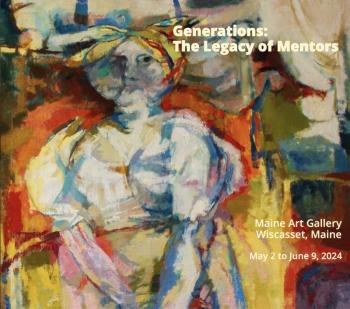 Tom Cavanaugh’s “Fish Cutter” is the cover of this show’s keepsake catalog. Gallery FB page
Tom Cavanaugh’s “Fish Cutter” is the cover of this show’s keepsake catalog. Gallery FB page
Maine Art Gallery’s current show, “Generations: The Legacy of Mentors,” celebrates the relationship between aspiring artists and their mentors. It also exemplifies each mentor’s impact on the mentee’s work, years and decades later. The opening reception on May 4 drew 250 people! That’s got to be some kind of record, right there. The show features two works by the artist and two works by the mentor. This column focuses on Marguerite Robichaux and her mentor Tom Cavanaugh.
Tom was a vastly accomplished artist, professor, author and self-taught musician who established Bay Street Gallery in Boothbay Harbor in 1950 - 2013. The eclectic gallery included a large summer lodge/guest house with studio space for artists, writers and musicians seeking a place to create. People who have been around these parts during those decades no doubt remember Tom well. One of the unique facets of this gallery was its “street gallery.” He was the first in the region to have paintings exhibited on one outdoor area, actually one of the walls of the gallery. Tom would display four to six paintings, depending on the size of each work, every morning. Around 2000, an unusual collection of 20th century antiques was included at Bay Street Gallery.
Tom was 96 years old when he died in November 2019. Before then, in a nutshell, he exhibited in over 160 regional, national and invited shows and had 20 solo shows. His work was exhibited in New York City at The Met and the Whitney Museum of American Art, and the Corcoran Biennials in Washington, D.C. He was listed in “America’s Who’s Who in American Arts,” for 21 years. He won a Fulbright Award in 1956. Tom’s teaching career included a professorship at Louisiana State University (LSU) from 1957 to 1983. For 16 years, Tom was director of painting and drawing at the School of Fine Arts, from which he retired as a professor emeritus.
Enter fine arts major Marguerite Robichaux, a student at LSU where she earned her MFA in 1974. Although she wasn’t in any of Tom’s classes, their paths crossed and in 1970 he invited her to come to work at his summer Bay Street Gallery to help with cooking for the lodge. Marguerite worked there for four consecutive summers and returned in 1976 and 1977 at Tom’s request. Theirs was not the typical mentor-mentee relationship; over the years a true friendship grew and remained strong throughout Tom’s life.
“My years with Tom at Bay Street Gallery were life-changing,” said Marguerite. “He became more of a life mentor, really. We developed a very close friendship – eventually even knowing each other’s families. It was quite an experience for me; there I was, an 18-year-old from the South (born in Alabama, but grew up in Louisiana), hired to do cooking and help out the artists, musicians, and writers there. Boothbay Harbor was the first time I’d been that far north. I never took a class from Tom while I was there. Being together, seeing each other work, getting his take on my work ... that was what the actual mentorship was like. He also helped me a lot with my sense of color and palette in painting; Tom was a great colorist. I would have people stopping by the gallery just sit for me. I was already a good figure drawer and Tom encouraged me to keep up with my draftsmanship.”
I was curious about one particular painting I’d come across in the Boothbay Register archives Tom used to accompany a press release dated Aug. 13, 2013 announcing a show of 29 of his works, shipped from his home in Navarre Beach, Florida. The painting, entitled “Baptism,” was one of 36 paintings in that show. Tom’s use of color and shadow in this depiction of slaves in white robes walking down to a river or creek, some in the water, (self-baptism, perhaps?) in the shadow of a church in the distance. With the exception of their white clothing, the painting is dark and somber; the Spanish moss hanging off the trees is both protective and off-putting. As I began describing it, Marguerite knew it instantly.
“Yes, that was from his Plantation Series of the Antebellum Days, originally in a show in Baton Rouge,” she said. “(The series) depicted the lives of slaves, slaveholders ... For Tom, it wasn’t a political thing; he did ‘genre’ painting a lot. He also used a lot of washes – including one of oil paint thinned with turpentine that I admired and emulated – Tom used them to blur the edges of paintings, including ‘Baptism.’”
Marguerite is renowned for her landscapes of the forests and mountains of Maine – and Vermont; places that are still untouched, or relatively untouched by progress, where wildlife can live, still. “I pretty much do paint pure landscape. I paint to bear witness to the importance of preserving our natural environment, locally and globally. I’ve painted landscapes that 10 years hence are not there anymore,” she explained. “Rural landscapes are being developed; forests are cut down, roads and subdivisions go up in hay fields … Just go to Sugarloaf – building is happening around the Mountain, on the Mountain, along Route 27.”
If there are telephone poles and lines, or buildings, Marguerite edits them out. The natural world and the preservation and celebration of it is always close to her heart. In 2011, she and good friend, and award winning writer, Elizabeth Peavey, teamed up on the book, “Glorious Slow Going: Maine Stories of Art, Adventure and Friendship.” The book features Marguerite’s oil and watercolor paintings and Elizabeth’s essays and stories, about some of their outdoor adventures in Maine.
Marguerite also works in graphite, but oil is her preferred medium. Back to that drip technique seen in many of her scenes ... Emulating that particular wash of oil paint thinned with turpentine, Marguerite’s adaption is used for what has become her signature “drip technique.” Dabbing her brush in oil paint thin as watercolor, Marguerite drips the liquid from a brush onto a canvas – and voilà! You can see it in many of her landscapes ... look at “Little Poplar Falls” (that accompanies this column online), on the right, where the water is cascading over the rock and in the water, reaching the pooled water you can see some drip lines; and there are more that appear to hang from the tree branches and again in the water reaching the pooled water below.
I asked Marguerite what were key elements seen in her landscapes. She noted some of her earlier work from Vermont and in the mountains of Maine. “If you look at (mountains) as more abstract, they can be likened to a nude or figure painting. You can see the rise in the hills as the hip of a reclining nude. Large mountain ranges become body parts; they can be quite sensual that way. There is that element of (the human) figure influencing the way I view landscapes.”
To that point, she added an anecdote from one of her painting trips to Ireland and the country’s very vertical waterfalls. One in particular she painted, was eight inches wide and 30 inches tall. As she watched it, watched the way the water moved down the rock and thought, “Ooooh, these are real sexy.”
Rock and water talk moved our conversation to Monhegan – a natural segue, right? In 1990, Marguerite received two grants: one to attend the Vermont Studio Colony and the other for a six-week residency on the Island. The latter she found quite intimidating. “All of these fabulous painters – 100s of them – well-known, internationally known, respected, had already painted there. Everything had been painted before. What did I think I was going to do? I had to find my own voice. That experience helped to define my artistic method. It was so inspirational! I painted more paintings in those six weeks than I could paint in one year at home.”
Speaking of home, Marguerite was in her winter home in Baton Rouge when the time came to send some work in for the Maine Art Gallery (MAG) show, so no large paintings will be there. One is a mountain scene (naturally) in the fall with that season’s palette and the other is a view looking out from Monhegan. Mentor Tom Cavanaugh’s “Fish Cutter” was selected by MAG as the cover of its keepsake exhibition catalog of the show. Said Marguerite, “It’s a shady female figure. There’s a lot of bold color, a little broken up into geometric patterns with almost a Cubism influence.”
Said Marguerite, “Tom never knew a quiet moment. He was an entertainer, locals who were artist friends, the people at the Lodge, joined in the impromptu jazz sessions – Tom was a self-taught jazz pianist – some sessions ended up moving to Rocktide! He taught me how to drink martinis. We kept in touch from 1970 until he died. When he was teaching in Baton Rouge, and I was there visiting my mother, he’d stop in. We’d cook and have a martini. I visited him at his home in Florida and when Hurricane Opal, I think it was, destroyed it, he lived with me during the rebuilding. I knew Tom well and I loved him.”
“Generations: The Legacy of Mentors” runs through June 10. Maine Art Gallery is at 15 Warren St. in Wiscasset. Hours are Thursday through Sunday, from 11 a.m. to 4 p.m.

